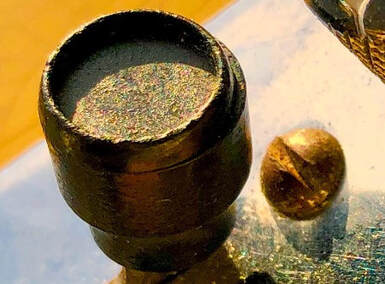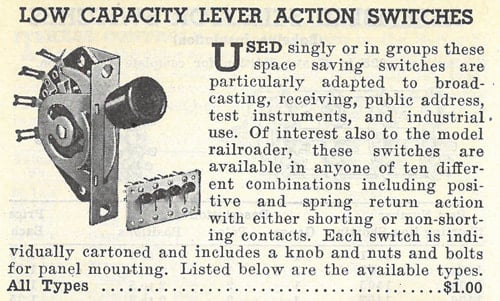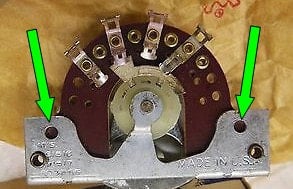#2 Patent Numbers
 Early 1452 switch: two patent numbers, black sheat and resistor
Early 1452 switch: two patent numbers, black sheat and resistor
Until the early '80s, Telecasters were equipped with a spring-loaded 3-way selector switch by Centralab, the CRL 1452. It consisted of chrome-plated chassis with closed top, dark brown phenolic rotor and dark brown phenolic stator holding the switch contact, which had flat side cuts until early '60s.
The early '50s CRL 1452 usually featured two patent numbers (PATS 2,291,516 and 2,291,517) and the "MADE IN U.S.A." stamp, not always clearly visible due to oxidation, while "CRL 1452" was stamped on the back of the chassis. A few Esquires, Broadcasters, NoCasters and early Telecasters sported the old “horse-shoe” CRL 1452 version.
The '50s and early '51 dual-pickup guitars featured a black or bright-colored sheath covering the cloth wires alongside the switch. Until late 1952 dual pickup models featured an Allen-Bradley 15K Ohm carbon resistor soldered on the CRL switch.
The early '50s CRL 1452 usually featured two patent numbers (PATS 2,291,516 and 2,291,517) and the "MADE IN U.S.A." stamp, not always clearly visible due to oxidation, while "CRL 1452" was stamped on the back of the chassis. A few Esquires, Broadcasters, NoCasters and early Telecasters sported the old “horse-shoe” CRL 1452 version.
The '50s and early '51 dual-pickup guitars featured a black or bright-colored sheath covering the cloth wires alongside the switch. Until late 1952 dual pickup models featured an Allen-Bradley 15K Ohm carbon resistor soldered on the CRL switch.
#3 Patent Numbers
A third patent number (2503885) was added on the chassis after the mid-'50s. This version had the top cut open so you can see inside the switch as you look down on the switch lever.
In late 1962, the CRL 1452 switch was redesigned and, between 1962 and 1963, it gradually replaced the previous one. The new switch was smaller, a new half-moon stator featured rounded edges, the rotor material changed from phenolic (brown) to glass epoxy (white) and the chassis featured two extra little holes.
In late 1962, the CRL 1452 switch was redesigned and, between 1962 and 1963, it gradually replaced the previous one. The new switch was smaller, a new half-moon stator featured rounded edges, the rotor material changed from phenolic (brown) to glass epoxy (white) and the chassis featured two extra little holes.
#1 Patent number and Diamond Logo
At first, all the three patent numbers were retained and the chassis had the top cut open and the two extra holes. However, the first two patent numbers were deleted soon and only the third one remained stamped on the chassis. This switch design was changed to a closed top, which was used until 1965 then for some reason they changed it again.
Since 1965, some CRL 1452 switches featured a diamond-shaped logo stamped on the chassis. This logo was always stamped on '70s units.
It seems that the CRL 1452 switches from the '70s were only assembled in the United States, while the components came from Japan, despite of the "MADE IN U.S.A." stamp.
Other switches were rarely used. However, they were not common, because Fender bought very few.
Since 1965, some CRL 1452 switches featured a diamond-shaped logo stamped on the chassis. This logo was always stamped on '70s units.
It seems that the CRL 1452 switches from the '70s were only assembled in the United States, while the components came from Japan, despite of the "MADE IN U.S.A." stamp.
Other switches were rarely used. However, they were not common, because Fender bought very few.
Switch Tip
 Open-top barrel like tip, Courtesy of Eddie Tatton
Open-top barrel like tip, Courtesy of Eddie Tatton
Small barrel-like switch tips used between 1950 and mid-1956 were made by Harry Davies Company of Chicago.
The earliest tips were open/hollow on the top and stamped only with the words “PAT. PEND.” on the bottom. After mid-51, the markings underneath read “DAKA · WARE” and “CHICAGO” with a patent pending indication “PAT. PEND.” and “2189845”.
The closed round-top version was adopted in 1952 and replaced the open/hollow hat switch tip.
The bigger top-hat switch tip first appeared in mid-1954 and gradually replaced the barrel tip, which was used consistently until mid-1956. However it is possible to find the barrel switch tip in 1957, too.
At first, the top hat tip retained the “DAKA · WARE” and the other markings, but it lost its Daka-Ware branding in the course of the ‘70s. It remained a standard feature of most Telecaster guitars until 1985.
However, it was not uncommon to find other switch tips made in different styles and shapes on ‘50s Telecasters.
The American Standard Telecaster introduced in late 1987 featured an original style barrel switch tip.
It is important to bear in mind that ‘70s Deluxe and Custom models were fitted with a Gibson-style toggle switch with white or black screwed-on tip.
The earliest tips were open/hollow on the top and stamped only with the words “PAT. PEND.” on the bottom. After mid-51, the markings underneath read “DAKA · WARE” and “CHICAGO” with a patent pending indication “PAT. PEND.” and “2189845”.
The closed round-top version was adopted in 1952 and replaced the open/hollow hat switch tip.
The bigger top-hat switch tip first appeared in mid-1954 and gradually replaced the barrel tip, which was used consistently until mid-1956. However it is possible to find the barrel switch tip in 1957, too.
At first, the top hat tip retained the “DAKA · WARE” and the other markings, but it lost its Daka-Ware branding in the course of the ‘70s. It remained a standard feature of most Telecaster guitars until 1985.
However, it was not uncommon to find other switch tips made in different styles and shapes on ‘50s Telecasters.
The American Standard Telecaster introduced in late 1987 featured an original style barrel switch tip.
It is important to bear in mind that ‘70s Deluxe and Custom models were fitted with a Gibson-style toggle switch with white or black screwed-on tip.














